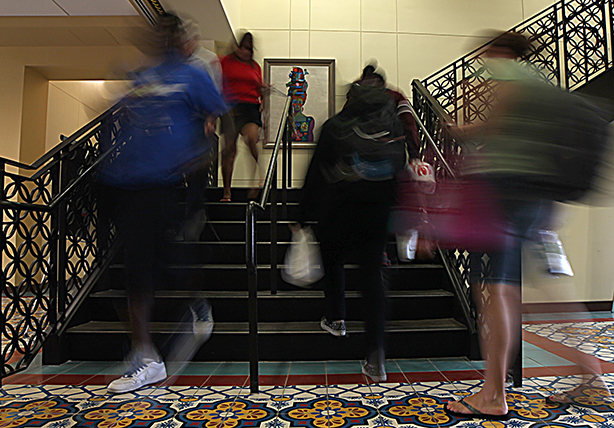
By Emily Rodriguez
Texas A&M University-San Antonio prides itself on holding the rank of the fastest-growing university in the state. That tagline was challenged after this semester’s Sept. 10 census date when university administration announced enrollment fell below the projected Fall 2014 milestone.
A&M-San Antonio anticipated a six percent increase in enrollment for the fall semester, potentially boosting student population to 4,800 students, but did not meet that goal. Student enrollment sits at 4,522, just slightly higher than the 4,512 students enrolled during the spring.
But the decline in university enrollment is not unique to San Antonio. Administrators across the country are taking stock of a decreased numbers of students.
For the last two years, college enrollment has decreased across the country; a large proportion of that decline is taking place at two-year community colleges. College enrollment declined by close to half a million (463,000) between 2012 and 2013, marking the second year in a row that a drop of this magnitude has occurred, according to a U.S. Census Bureau report released earlier this week.
“Across the nation student enrollment is down for the second year in a row. That could begin to impact us. When the economy is a little bit better typically graduate students don’t go back to school, they’re working and not advancing their degree,” said Eric Cooper, assistant vice president for enrollment management.
The university considered over 3,000 applications for the fall semester and admitted 2,036 of those applicants.
Cooper attributed the slowenrollment growth for the fall semester to the rise in minimum GPA required by the College of Education and Human Development, the limited pool of students the university can recruit from, and funding.
“We’re still upper division so we still rely on a transfer population. The transfer population has to be TSI compliant. Since we don’t offer any lower division courses we have to wait until they meet the minimum number of credits as well,” Cooper said, referring to the the Texas Success Initiative (TSI) that sets a minimum skill level students must have in reading, writing and math.
To become a certified teacher students must graduate with a 2.75 GPA, an increase from the previous 2.5. This was done in anticipation of a statewide mandate said Eric Lopez, dean of the College of Education and Human Development. The GPA needed to receive a degree in education from this university remains at 2.0.
According to a prospective student transfer guide, students pursuing a bachelor’s degree in education must maintain a 2.75 average to stay in the program.
In addition to the GPA change, graduate students must meet the minimum score required in either the Miller Analogies Test or Graduate Record Examination to continue in the program.
The minimum score needed on the exams depends on a student’s GPA and can be found on the graduate admissions catalog.
“The 2.75 can be cumulative or based on their last 60 hours, that’s according to state standard,” Lopez said. “Now we’re adhering to minimum standards to enter graduate school. To obtain our accreditation for SACS (Southern Association of Colleges and Schools) we had to adjust and start adhering to them.”
As of Sept. 15, the College of Education and Human Development saw a 9 percent decrease in enrollment compared to the spring semester. The College of Arts and Sciences and the College of Business had nearly a 6 percent growth in student population.
Lopez said he is unsure if the requirement changes are the cause of the college’s and the university’s enrollment drop, but college departments are working with enrollment management to come up with sustainable recruitment strategies to attract students.
Small class sizes, brand new buildings and the university’s location are among some of the selling points that are used by recruiters to attract students to apply. A lack of a freshman and sophomore classes, student housing, sports and degree programs present challenges to recruiters.
During the last legislative session, A&M-San Antonio did not receive the tuition revenue bonds it asked for that would have been used to construct new buildings. The next legislative session begins in January and the university will continue to ask for additional funds for new buildings and retention and support programs.
“We’re a transfer school. Some students think it’s a scary decision because they aren’t sure if they’re losing credits. It’s much easier to start at a university as an incoming freshman than transfer in as a junior,” recruiter Daniella Gonzalez-Dendy said, adding that recruiters make efforts to stay in touch with prospective students to ease the transfer process.
Enrollment and recruitment have created various events such as Jaguar Day and social media efforts to encourage prospective students to visit the campus and see what the university has to offer, and keep them updated on upcoming enrollment deadlines and recruiting days.
“When it comes to numbers, the mentality is different in recruitment. We are an upper division school so we work with junior colleges, early college high schools, we’re limited in our audience,” Gonzalez-Dendy said. “Our job this year is not only to get our name out there but to plant our seeds in students who will be our future four or five years from now.”





